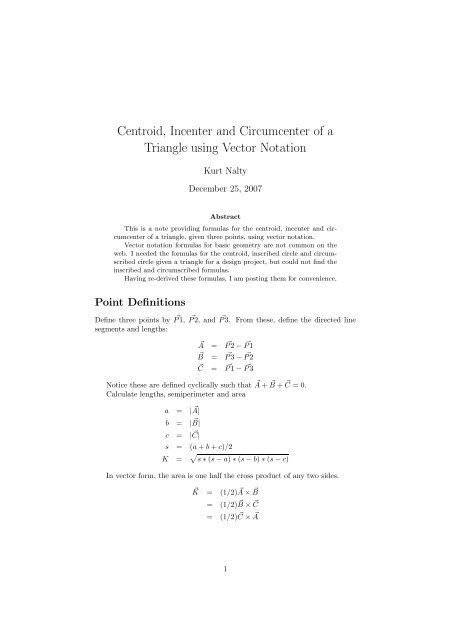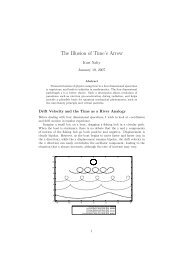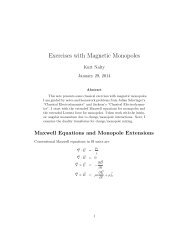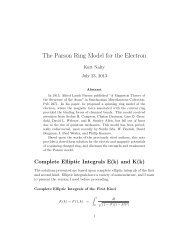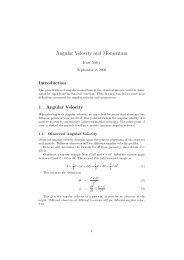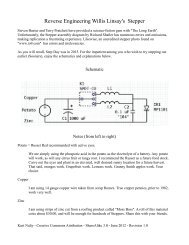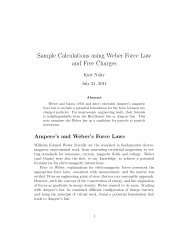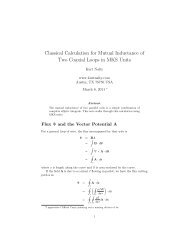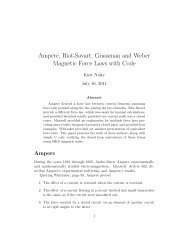Centroid, Incenter and Circumcenter of a Triangle using ... - Kurt Nalty
Centroid, Incenter and Circumcenter of a Triangle using ... - Kurt Nalty
Centroid, Incenter and Circumcenter of a Triangle using ... - Kurt Nalty
Create successful ePaper yourself
Turn your PDF publications into a flip-book with our unique Google optimized e-Paper software.
<strong>Centroid</strong>, <strong>Incenter</strong> <strong>and</strong> <strong>Circumcenter</strong> <strong>of</strong> a<br />
<strong>Triangle</strong> <strong>using</strong> Vector Notation<br />
<strong>Kurt</strong> <strong>Nalty</strong><br />
December 25, 2007<br />
Abstract<br />
This is a note providing formulas for the centroid, incenter <strong>and</strong> circumcenter<br />
<strong>of</strong> a triangle, given three points, <strong>using</strong> vector notation.<br />
Vector notation formulas for basic geometry are not common on the<br />
web. I needed the formulas for the centroid, inscribed circle <strong>and</strong> circumscribed<br />
circle given a triangle for a design project, but could not find the<br />
inscribed <strong>and</strong> circumscribed formulas.<br />
Having re-derived these formulas, I am posting them for convenience.<br />
Point Definitions<br />
Define three points by ⃗ P 1, ⃗ P 2, <strong>and</strong> ⃗ P 3. From these, define the directed line<br />
segments <strong>and</strong> lengths:<br />
⃗A = ⃗ P 2 − ⃗ P 1<br />
⃗B = ⃗ P 3 − ⃗ P 2<br />
⃗C = ⃗ P 1 − ⃗ P 3<br />
Notice these are defined cyclically such that ⃗ A + ⃗ B + ⃗ C = 0.<br />
Calculate lengths, semiperimeter <strong>and</strong> area<br />
a = | ⃗ A|<br />
b = | ⃗ B|<br />
c = | ⃗ C|<br />
s = (a + b + c)/2<br />
K = √ s ∗ (s − a) ∗ (s − b) ∗ (s − c)<br />
In vector form, the area is one half the cross product <strong>of</strong> any two sides.<br />
⃗K = (1/2) ⃗ A × ⃗ B<br />
= (1/2) ⃗ B × ⃗ C<br />
= (1/2) ⃗ C × ⃗ A<br />
1
<strong>Centroid</strong><br />
The centroid is the true average coordinate. This center is the intersection <strong>of</strong><br />
the segment bisectors to opposite vertice.<br />
⃗G = (1/3) ∗ ( ⃗ P 1 + ⃗ P 2 + ⃗ P 3) (1)<br />
<strong>Incenter</strong><br />
The inscribed circle center is given by the weighted average <strong>of</strong> the coordinates<br />
by the opposite side. The center is the intersection <strong>of</strong> the three angle bisectors.<br />
The radius <strong>of</strong> the inscribed circle is<br />
⃗I = (b ∗ ⃗ P 1 + c ∗ ⃗ P 2 + a ∗ ⃗ P 3)<br />
a + b + c<br />
(2)<br />
r = √ (s − a) ∗ (s − b) ∗ (s − c)/s<br />
= K/s<br />
<strong>Circumcenter</strong> or Exocenter<br />
The circumcenter or exocenter is found by erect perpendicular bisectors from<br />
each side. This center is the intersection <strong>of</strong> these lengths. Building <strong>of</strong>f the ⃗ P 1 -<br />
⃗P 3 line, we have<br />
⃗E = (1/2)( ⃗ P 1 + ⃗ P 3) + ⃗ A · ⃗B<br />
8K 2 ( ⃗ C × ( ⃗ A × ⃗ B)) (3)<br />
The radius <strong>of</strong> the circumscribed circle is<br />
Notes<br />
R = abc<br />
4K<br />
The equation <strong>of</strong> a line through a point is<br />
⃗L = ⃗ P + s⃗u<br />
where ⃗ P is the known point, s is the distance travelled on the line from that<br />
point, <strong>and</strong> ⃗u is the direction <strong>of</strong> the line (as a unit vector).<br />
The distance between a point ⃗ C <strong>and</strong> a line defined by two points ⃗ P 1 <strong>and</strong><br />
⃗P 2, as found by triangular area, is<br />
d = |( ⃗ P 2 − ⃗ P 1) × ( ⃗ C − ⃗ P 1)|<br />
| ⃗ P 2 − ⃗ P 1|<br />
2


